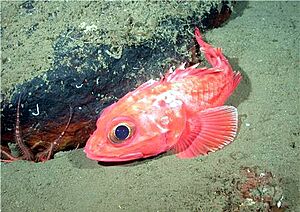Shortspine thornyhead facts for kids
Quick facts for kids Shortspine thornyhead |
|
|---|---|
 |
|
| Conservation status | |
| Scientific classification | |
| Synonyms | |
|
The shortspine thornyhead (Sebastolobus alascanus) is a type of fish that lives in the ocean. It's also known as the channel rockcod or spinycheek rockfish. This fish is part of a group called rockfishes. Some people even call it the "idiot fish" because it has a really big head and eyes! You can find it in the northern and northeastern parts of the Pacific Ocean.
Contents
About the Shortspine Thornyhead
How it Got its Name
The shortspine thornyhead was first officially described in 1890. An American scientist named Tarleton Hoffman Bean gave it its scientific name. He found this fish near the Trinity Islands in Alaska. That's why its scientific name, alascanus, means "Alaskan".
What it Looks Like
The shortspine thornyhead has a large head with a spiny ridge. Its body is long and gets thinner towards the tail. This fish can grow up to 80 centimeters (about 31 inches) long.
It has two main fins on its back called the dorsal fin. One part has 15 to 17 sharp spines, and the other has 8 to 9 soft rays. The fin on its belly, called the anal fin, has 3 spines and 4 to 5 soft rays. Its side fins (pectoral fins) have a deep notch, and its tail fin is rounded.
This fish is usually bright red. It often has black marks on its fins. The inside of its gills is a pale color.
Where it Lives
You can find the shortspine thornyhead across the North Pacific Ocean. It lives from the Sea of Okhotsk in the west, all the way to Baja California in the east. It also lives north into the Bering Sea and around the Aleutian Islands.
This fish lives near the bottom of the ocean. It can be found at depths from 17 meters (about 56 feet) down to 1,600 meters (about 5,250 feet). However, it usually prefers depths less than 100 meters (about 330 feet).
Life Cycle and Habits
How Long They Live
Shortspine thornyheads grow very slowly. They can live for a very long time, possibly up to 80 or even 100 years! Female fish usually grow bigger than males.
Reproduction
Female shortspine thornyheads become ready to have babies when they are about 18 centimeters (7 inches) long, or around 8 to 10 years old. The females lay their fertilized eggs in jelly-like masses that float in the open ocean. As the young fish grow, they move to deeper waters.
These fish usually lay their eggs between December and May along the Pacific coast of the United States. In the Gulf of Alaska, they lay eggs between April and May.
What They Eat
Shortspine thornyheads are predators. This means they hunt and eat other smaller creatures. They mainly eat shrimp, crabs, and other small animals that live on the ocean floor. They also eat tiny floating animals called zooplankton.
Surviving in Deep Water
Adult shortspine thornyheads often live in areas of the ocean where there isn't much oxygen. This is called the oxygen minimum zone. To survive, they have special ways to deal with low oxygen levels. For example, they can breathe faster when there's less oxygen. Their bodies also have special ways to make energy even when oxygen is low.
Conservation Status
Scientists regularly check on the shortspine thornyhead populations. In areas like Alaska, British Columbia, and the West Coast of the United States, the fish populations are considered healthy. This means there are enough fish, and people are not catching too many of them.
However, the IUCN (International Union for Conservation of Nature) listed the shortspine thornyhead as "Endangered" in an assessment done in 2000.


